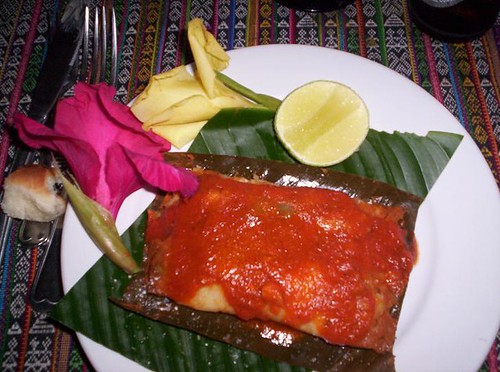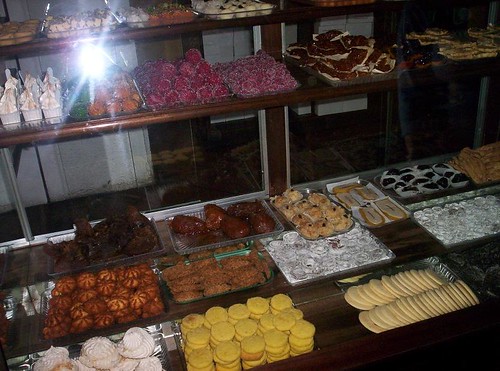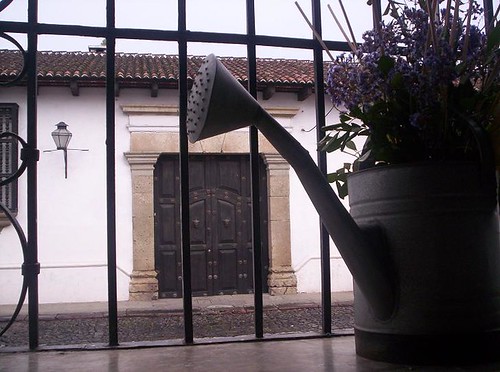At least once every few years while I was growing up, my parents, brother and I visited my father’s family in Guatemala City. These were always highly anticipated visits; from the instant the rolling green mountains swam into view from the plane window and we lugged our luggage into the great, cedar-fragrant Colliseum-shaped arrivals area of La Aurora airport, I felt ready to implode with excitement. After the joyful reunions, there were the usual celebratory fiestas at my aunt and uncle’s apartment building. There were the giddy whispered catch up conversations with our cousins, huddled into whichever secret space we could cram ourselves into as the adults enjoyed rum and cafe con leche. There were the longed-for meals; spicy green pumpkin and chicken jocon stew ladled lovingly over rice, bowls heaped with mounds of creamy black frijoles accompanied by steaming baskets of delicate pan frances plus the star in my fevered dreams of Guatemalan fare – the earthy corn tamal, steamed in a banana leaf, stuffed with chicken, red peppers and olives, squeezed over with squirts of lime.

And, of course, there were the obligatory day trips to Antigua that made my cousins groan – ay no; otra vez??? – but stirred within me a secret delight.

the famed Santa Catalina Arch


dulces tipicos

from a cafe window
Antigua, once the capital of Guatemala, is characterized by gorgeous colonial Spanish architecture and narrow, cobbled streets. Squat, square houses in shades of pink, green and yellow line the cobblestones, interrupted by grandiose palatial churches and squares lush with stone fountains. Everywhere, native Antiguans in their traditional garb sell traditional Guatemalan wares; sweets, ceramics, wooden furniture, brightly colored woven textiles. When I was a child, a visit to Antigua was like a trip in a time machine, one that never failed to impress me. I was a huge fan of The Mysterious Cities of Gold, after all. My father, who was born in Antigua, liked to tease me by telling me that he had seen Esteban – the child of the sun! – just around a corner. Even as an adult, I can still imagine I see him there.
[youtube=http://uk.youtube.com/watch?v=BO83HUmy0Rs]
It was during one of these happy day trips to Antigua, perhaps when I was 13 or so, that my mother broke from our crowd, fished her camera out of her purse and scurried over on her high heels to a Antiguan woman who had set her wares out on a street corner and was now sitting among them on a red woven blanket. I watched, horrified, as my mother snapped a picture in the woman’s face.
“How could you do that?” I blurted as my mother returned, triumphant.
“What?”
“You just took a picture of that woman like she was … like she was La Merced Church. Or a penguin at the zoo! ”
“What?” my mother said. “She was beautiful.”
“You can’t do that!” I said, with the first traces of a righteous fervor that would one day result in my being diagnosed with Bleeding Liberal Heart syndrome. “People aren’t tourist attractions. They’re people!”
“Well, I’m sorry.” my mother said. “I just didn’t think. I thought she looked so wonderful sitting there with her ceramic houses all around her and her hair all braided with the ribbons and her robes. I thought she’d make a beautiful picture.”
I wouldn’t hear it; mortified, I dared a glance at the woman who, from the looks of it, hadn’t even registered the fact that for a few brief seconds, she’d been my mother’s muse. It was a small comfort.
15 years later, I live in Japan. Each day, I leave my bat cave apartment and step into weather that is increasingly sunny and moist. I walk down the shopping arcades and spy upon cases of fresh red tuna or pass a serene shrine haplessly located between a McDonalds and a Tsutaya store. It is inevitable that I will run into people, and it is inevitable that the people I see on the streets will be doing or wearing something that catches my breath, because it will be something I consider so emotionally evocative, or so representative of my experience here in Japan. And then, despite myself, I begin to feel what my mother most likely felt on the streets of Antigua that day so many years ago. They are images that mustn’t be kept to myself, and they are so vivid that I fear my words won’t do them justice. Sometimes, I feel my fingers curl around my camera inside my purse. I imagine that the woman I want to photograph won’t even notice me because she’s busy buying takoyaki. I imagine the children will forget I’ve photographed them like a tourist attraction the minute they get distracted by a neon sign. I try to imagine that I can forget it, too but know I cannot.
And then I see a teenage girl standing on line for the train, dressed in a mint green kimono emblazoned with large butter yellow blossoms, her white obi artfully folded into a swirled bow at her back, her hair swept up in delicate curls, barely hiding her Ipod’s fuchsia rhinestone earbuds. Or I see an elementary schoolboy waiting for the train in his pale blue school uniform, his navy shorts cut high above his knobby knees, his shiny black hair covered by a crisp brimmed hat and his back laden down by the stiff, gleaming leather box-like backpack all children get when they begin kindergarten. These backpacks are reminiscent of something Heidi would have worn and I glowed with the idea of buying some for my friends’ kids until I learned that these backpacks cost hundreds of dollars.
I see a homeless man, his hair matted into dreads that cascade down his back, his exposed muscles wasted but his gapped smile full of blackened teeth wide as he sits besides his immaculate cardboard box home outside of the Matsuya in my neighborhood. He washes himself with a long, rumpled skein of plastic wrap, grasping it between two fists as he saws it back and forth between his shoulder blades until the caked dirt slides off. His cardboard home is hardly unusual – several of these are lined up outside the train station gates to form a fantastic cardboard suburb.
I see toddlers, squirmy and fat, with fresh pink cheeks and bare feet with chubby toes squealing in their mothers’ laps and playing with their cell phones as they point to the women on the train and proudly dub them either “onei chan” (big sister) or “mama.” I won’t tell you which one they deemed me. My three year old student, Masa, flaps his little hand at me at the end of each class and chirps, “mata!*” I don’t want to stop at just a picture for him – Masa deserves his own video.
*until next time!
I see sarari men, vermillion-faced, staggering out of izakayas, bellowing Kojima Yoshio’s famous catchphrase, before they spew the contents of their previously beer-filled stomachs onto the izakaya wall, sending the wait staff into a tizzy of “Excuse me”s and a hunt for air freshener. I see teenage girls in school uniforms crowded outside a shrine, discussing what I’m sure has nothing to do with the shrine’s history or what they learned in school that day. I see garu clattering down the streets in 6 inch platform shoes, fake tanned skin the color of satsuma, their Barbarella hair arching towards the sky and goth makeup smeared down their cheeks. Sometimes there are girls wearing flouncy, tiered Strawberry Shortcake dresses and giant, floppy berets to match. When they pass on the street, even school children turn to giggle.
People impress me every day and my fingers itch to capture them so that I never forget. But words will have to suffice.